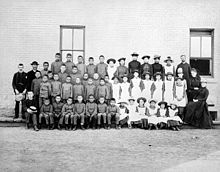User:Logitech322/North American Indigenous hairstyles
This article has multiple issues. Please help improve it or discuss these issues on the talk page. (Learn how and when to remove these messages)
|
To the Indigenous peoples on Turtle Island, North America, their hair carries cultural significance and relevance to their identity.[1] Each tribe has a different cultural teaching in regard to hair and hairstyles but the core significant to cultural identity remains the same.[2] It is commonly known within the Indigenous community that because of the importance hair has to cultural identity, one should not, unless given permission, touch another's hair.[3] Hair is perceived as an outward expression of internal thoughts to Indigenous peoples, and there are various signifiers for cutting it; ranging from grief to distancing a personal self from past mistakes.[3] There are different known hairstyles for any Indigenous groups,[1] along with varying rituals during the styling process. It is believed that in the occasion of cutting hair to get rid of past ties the best time to do so is during a Full Moon, and when cutting hair to welcome a fresh start and/or trimming hair it is best to do during a New Moon.[3] With no directly homogenous teachings and styles with Indigenous hair, the act of cutting it also varies from tribe-to-tribe.[1] The Diné (Navajo) believe cutting off hair is to represent mourning whereas the Apache believe haircutting as a ceremony for good health.[1]
Indigenous hairstyles
[edit]- Nêhiyawak: Braids
- Seminole: Boards Style
- Dinê (Navajo): tsiiyéél Buns
Historical relevance
[edit]
Residential schools
[edit]Residential schools in Canada began in the 1880's and were present till the last school closed in 1996. The goal of these schools were to "get rid of the Indian problem,"[4] as said by Deputy Minister of Indian Affairs Duncan Campbell Scott. This was attempted through the imposition of Christian religious beliefs and practices as a way of cultural assimilation and genocide. In these schools the Indigenous students were alienated from their families and culture, their hair was cut and they were not allowed to speak their native tongue or associate themselves with their culture.[5]
With the assimilating legacy of residential schools and the horrible actions of forceful hair cutting to "kill the Indian," it is of great importance to Indigenous people to grow and protect their hair as an act of cultural commitment and resiliency.[1]
Government influence
[edit]It is stated in the United States of America's Records of the Bureau of Indian Affairs Central Classified Files of 1907–1939 that, in reference to Indian Agents controlling the civilization of Indigenous peoples in the United States, "You are therefore directed to induce your male Indians to cut their hair.[6] Cutting of long hair and possessing short hair indicates shows a more civilized indiviudal.[6]
Contemporary presence
[edit]There is a current discourse around occurrences that are relevant to the importance of Indigenous hair, as well as the past and present discrimination towards this relationship. Such as;
- Seth Cardinal-Dodginghorse, a member of the Tsuu T'ina Nation, dramatically cuts off his two long braids to partake in small, personal protest against the Calgary Ring Road expansion as this highway encroaches onto his reservation and familial land, immediately prior to this act he says "With this, I leave a piece of me with the road."[7] This is referenced to his braids.
- Acts of bullying towards Indigenous boys with long hair are committed within the public education system, leading to children cutting off other Indigenous student’s braids.[8] As a response to this inequity, Michael Linklater, a Cree man, created a campaign titled “#BoysWithBraids” to end the bullying done upon these young Indigenous men for their long, braided hair. Linklater aims to bring awareness to the importance of braids to Indigenous men.
- Legislation in place as a response to inequitable treatment towards Diné/Navajo girls on a school basketball team in Phoenix, Arizona for wearing their hair in traditional tsiiyéél buns. Senator Carlyle Begay introduced legislation to support and protect Indigenous athletes and cultural wear/style.[9] This bill (SB1219), now law, states that the "governing board shall consider the cultural traditions of pupils when establishing or enforcing rules related to a pupils participation in extracurricular activities."[10]
References
[edit]- ^ a b c d e Blais-Billie, Braudie (2017-06-23). "Beyond Braids: The True Story of Indigenous Hair". i-D. Retrieved 2020-12-07.
{{cite web}}: CS1 maint: url-status (link) - ^ "The Significance Of Hair In Native American Culture". Sister Sky. Retrieved 2020-12-07.
- ^ a b c Johnstone, Paula Lightning Woman. "Hair Raising... A Spiritual Journey." Aboriginal Cultural Connections: A Child Protection Resource Guide. Prince Edward Island, Canada: Community Services and Seniors. [1]
- ^ MacDonald, David B.; Hudson, Graham (2012). "The Genocide Question and Indian Residential Schools in Canada". Canadian Journal of Political Science / Revue canadienne de science politique. 45 (2): 427–449. ISSN 0008-4239.
- ^ Charles, Grant; DeGagné, Mike (2013-10-01). "Student-to-Student Abuse in the Indian Residential Schools in Canada: Setting the Stage for Further Understanding". Child & Youth Services. 34 (4): 343–359. doi:10.1080/0145935X.2013.859903. ISSN 0145-935X.
- ^ a b Yumpu.com. "Records of the Bureau of Indian Affairs Central Classified ... - ProQuest". yumpu.com. Retrieved 2020-12-07.
- ^ "Man cuts hair off in wrenching protest over new road in Calgary: 'Imagine your home and your history removed'". thestar.com. 2020-10-01. Retrieved 2020-12-07.
- ^ "Son's braid cut at Calgary school: Indigenous mother hopes for teaching moment | CBC News". CBC. Retrieved 2020-12-07.
- ^ Rau, Alia Beard. "Navajo hair-bun ban prompts Arizona lawmaker to introduce this bill". The Arizona Republic. Retrieved 2020-12-07.
- ^ "SB 1219 - Arizona 52nd Legislature - 2nd Regular Session". Open States. Retrieved 2020-12-07.
Category:Native American people Category:Anti-indigenous racism in North America Category:Canadian Aboriginal and indigenous law Category:Indigenous culture in Canada Category:Indigenous culture in the United States
